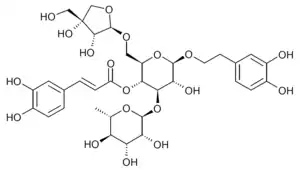Forsythoside B
Forsythoside B is a natural product from the phenylpropanoid glycoside group, which is found in a number of plant species such as Marrubium alysson, Phlomis armeniaca, Scutellaria salviifolia, Phlomoides tuberosa, Phlomoides rotata, Pedicularis longiflora and Teucrium chamaedrys, several of which are used in Chinese traditional medicine in preparations such as Shuanghuanglian (双黄连). It acts as an inhibitor of inflammatory mediators such as TNF-alpha, IL-6, IκB and NF-κB, as well as the temperature sensitive channel TRPV3, but also activates the RhoA/ROCK signaling pathway which can cause hypersensitivity reactions when it is injected intravenously.[1][2][3][4][5][6][7][8][9][10]
 | |
| Identifiers | |
|---|---|
| |
| CAS Number | |
| PubChem CID | |
| ChemSpider | |
| Chemical and physical data | |
| Formula | C34H44O19 |
| Molar mass | 756.707 g·mol−1 |
| 3D model (JSmol) | |
| |
| |
See also
References
- Caliş I, Hosny M, Khalifa T, Rüedi P (October 1992). "Phenylpropanoid glycosides from Marrubium alysson". Phytochemistry. 31 (10): 3624–6. doi:10.1016/0031-9422(92)83740-p. PMID 1368865.
- Saracoglu I, Inoue M, Calis I, Ogihara Y (October 1995). "Studies on constituents with cytotoxic and cytostatic activity of two Turkish medicinal plants Phlomis armeniaca and Scutellaria salviifolia". Biological & Pharmaceutical Bulletin. 18 (10): 1396–400. doi:10.1248/bpb.18.1396. PMID 8593444.
- Jiang WL, Fu FH, Xu BM, Tian JW, Zhu HB (July 2010). "Cardioprotection with forsythoside B in rat myocardial ischemia-reperfusion injury: relation to inflammation response". Phytomedicine. 17 (8–9): 635–9. doi:10.1016/j.phymed.2009.10.017. PMID 19959348.
- Jiang WL, Zhang SP, Zhu HB (July 2012). "Forsythoside B protects against experimental sepsis by modulating inflammatory factors". Phytotherapy Research. 26 (7): 981–7. doi:10.1002/ptr.3668. PMID 22147417. S2CID 32769238.
- Dimitrova P, Kostadinova E, Milanova V, Alipieva K, Georgiev M, Ivanovska N (November 2012). "Antiinflammatory properties of extracts and compounds isolated from Verbascum xanthophoeniceum Griseb". Phytotherapy Research. 26 (11): 1681–7. doi:10.1002/ptr.4641. PMID 22389249. S2CID 206428570.
- Frezza C, Venditti A, Matrone G, Serafini I, Foddai S, Bianco A, Serafini M (July 2018). "Iridoid glycosides and polyphenolic compounds from Teucrium chamaedrys L". Natural Product Research. 32 (13): 1583–1589. doi:10.1080/14786419.2017.1392948. PMID 29058476. S2CID 46602138.
- Zhang H, Sun X, Qi H, Ma Q, Zhou Q, Wang W, Wang K (January 2019). "Pharmacological Inhibition of the Temperature-Sensitive and Ca2+-Permeable Transient Receptor Potential Vanilloid TRPV3 Channel by Natural Forsythoside B Attenuates Pruritus and Cytotoxicity of Keratinocytes". The Journal of Pharmacology and Experimental Therapeutics. 368 (1): 21–31. doi:10.1124/jpet.118.254045. PMID 30377214.
- Liu JX, Li X, Yan FG, Pan QJ, Yang C, Wu MY, et al. (January 2019). "Protective effect of forsythoside B against lipopolysaccharide-induced acute lung injury by attenuating the TLR4/NF-κB pathway". International Immunopharmacology. 66: 336–346. doi:10.1016/j.intimp.2018.11.033. PMID 30521962. S2CID 56141148.
- Han J, Zhang Y, Pan C, Xian Z, Pan C, Zhao Y, et al. (December 2019). "Forsythoside A and Forsythoside B Contribute to Shuanghuanglian Injection-Induced Pseudoallergic Reactions through the RhoA/ROCK Signaling Pathway". International Journal of Molecular Sciences. 20 (24): 6266. doi:10.3390/ijms20246266. PMC 6940901. PMID 31842335.
- Yan K, Sun X, Wang G, Liu Y, Wang K (August 2019). "Pharmacological Activation of Thermo-Transient Receptor Potential Vanilloid 3 Channels Inhibits Hair Growth by Inducing Cell Death of Hair Follicle Outer Root Sheath". The Journal of Pharmacology and Experimental Therapeutics. 370 (2): 299–307. doi:10.1124/jpet.119.258087. PMID 31152005.
This article is issued from Wikipedia. The text is licensed under Creative Commons - Attribution - Sharealike. Additional terms may apply for the media files.